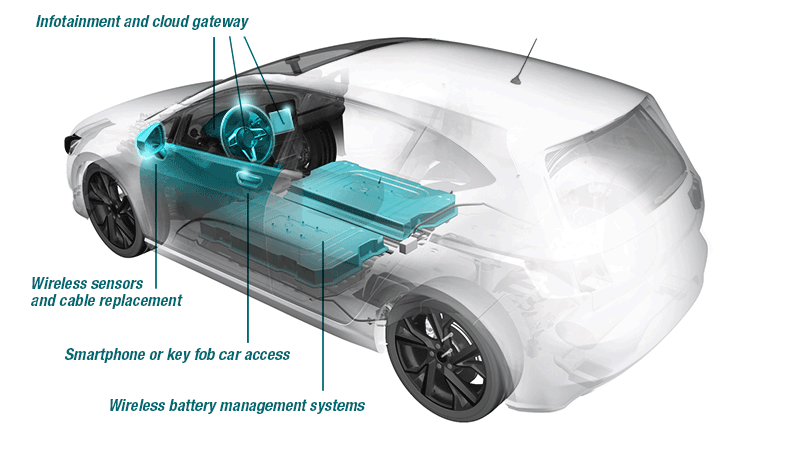SSZT333 february 2020 CC2541-Q1 , CC2640R2F-Q1 , CC2642R-Q1

Connectivity’s ubiquity in the world is certainly gaining momentum in the automotive industry. Many car owners think of automotive wireless connectivity as a simple interaction with an in-car infotainment system, but new applications are emerging, whether it’s personalizing an owner’s interaction with the vehicle, creating a path for lower-power connectivity operation when in the key-off state, or providing users the experience of passive entry via phone-as-a-key (PaaK) applications.
For several years now, TI’s Bluetooth® Low Energy technology has been connecting multiple elements within the car, including head units, tire pressure monitoring systems (TPMSs), telematics control units (TCUs), car access through PaaK and other accessories.
In 2014, TI created the CC2541-Q1 device, followed by the CC2640R2F-Q1 device in 2017 and now the CC2642R-Q1 device, which features 352 KB of available flash space and an Arm® Cortex®-M4F processor core, while maintaining the same low-power performance as the previous platforms. The device works in combination with the SimpleLink™ software development kit (SDK).
Let’s break down a simple example where TI Bluetooth Low Energy device are being used today. One of the latest trends is the use of Bluetooth Low Energy for car access via PaaK applications. This where a a vehicle owner can pair their phone with the car via Bluetooth, then the car and phone passively connect to one another to locate the phone and unlock the vehicle for permitted users. When designing car access systems, there are certain quality and reliability requirements needed. For example:
- Reliable interoperability with smartphones
- High performance in noisy and challenging environments
- AEC-Q100 qualified hardware
- Software development process that meets high industry standards for quality
- Low-power consumption in the key-off state
With the CC2642R-Q1 device, in combination with TI’s Bluetooth 5.1 stack in the SimpleLink SDK, you can leverage the sub-1-µA standby current, low-power transmit and receive currents (7.3 mA and 6.9 mA, respectively) and gain robustness, range and reliability in data transmission using the coded physical layers provided in the Bluetooth 5 specification.
Another use case where low power is a big requirement is in TCUs. Often, TCUs comprise high-power-consuming connectivity devices or elements such as cellular modems, Wi-Fi® and many other types of connectivity, depending on the vehicle. When the vehicle is in the key-off state, there are stringent power budgets that the vehicle must maintain in order to not drain the battery.
Therefore, some sort of system is required that allows the vehicle to shut off the higher-current-consuming components of the vehicle but still wake up when needed. While there are several options for connectivity within the car, Bluetooth Low Energy is a great option for quality and reliability. It is often used as a way to enable the TCU to determine whether it needs to wake up to handle software updates or any other diagnostic functions. TI envisions the trend of using Bluetooth Low Energy to connect applications within the car will continue to increase as vehicles become more technologically advanced and connected.
Additional Resources:
- To learn more about TI’s latest device in the Bluetooth Low Energy automotive family, check out the CC2642R-Q1 product folder.
- Check out our wireless BMS video.